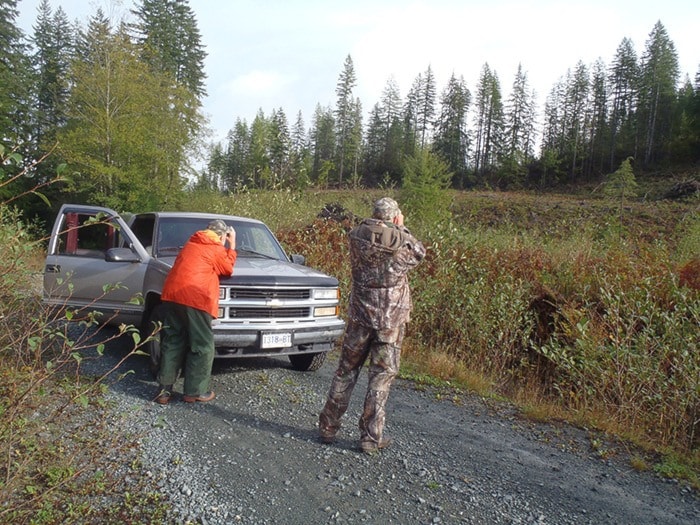We are well into the middle of our annual hunting season and it is time to have a brief look at this traditional method of food gathering that people have pursued for thousands of years.
In my family’s case I can trace our connection with hunting back to the 12th century by looking at the family crest of the Shaw clan in Scotland. Be that as it may, I do know that we have a solid family tradition of being outdoor people as in fishing and hunting.
This is probably one of the ancestral reasons why I was pleased to spend three days last week hunting deer with Michael Farrell, one of my grandsons who came over from Vancouver to partake in a couple of family hunts.
The picture accompanying the column is of Michael and Smitty leaning over the front of my truck, carefully glassing a deer that was lying in the slash about 200 yards from the truck. Try as they did, they could not grow antlers on it.
The day Smitty joined us, Michael assured us that we could shoot a deer out in the slash and he would retrieve it for us. This was pretty special because when you get the other side of 90 years, as in Smitty’s case, it is pretty nice to know when you do shoot a deer there is some retrieving help close at hand.
We hunted for three days in the open logging slash north of Campbell River. If you recall last week it was pretty wet with periods of heavy rainfall. Each day we saw at least six deer and one day it was seven. Of all the deer we sighted only one of them may have been a buck and since we were hunting in an area where only bucks were open we didn’t do any shooting.
We did do a small test based on John Alden Knight’s solunar tables. The results were surprising and I suggest they will pay off in the future. Most people use the tables for fishing, but I believe they are also a factor in movements of birds and animals as well.
The evening before our first day of hunting I suggested to Michael that we should consider the solunar tables for our first day of hunting. He had never heard of them, but when I showed him the tables in the Tide & Bite Guide he agreed to give it a try. We would be hunting anyway.
The tables showed that on Oct. 22 there was a major period at 2:35 p.m. Now we were looking at fishing tables, but it is my experience that they also apply to animal and bird movements.
Michael was generous in going along with his old grampa. At about 2 p.m. I parked the truck in a large clear-cut, with a good location to use our binoculars in glassing the forest edge and logged slopes. When we parked we could not see any deer. About 2:15, three deer appeared at the forest edge and moved to feed in the clearing. Shortly after, another deer came out of the forest and proceeded to feed. Unfortunately none of them had antlers, so we enjoyed the wildlife show in front of us for a while then moved off to hunt other areas.
On Oct. 23 the solunar period was about 3:20 p.m. When we parked the truck to glass the clear-cut in front of us, again there were no deer in sight. Surprisingly at about 3:30 we had five deer in sight and actively browsing. They paid no attention to the truck because we were at least 250 yards from them.
On Oct. 24 the solunar period was about 4:10 p.m. We had seen other deer in our travels but at about 3:45 we parked the truck in a suitable location to watch for deer. As if reporting for work a large doe came out of the forest and proceeded to feed along the edge of the clearing.
In the three days we had followed the tables we had at least 20 deer sightings – but none of them were wearing antlers. Notwithstanding, we observed animals every day, including one bear and numerous grouse. Michael did shoot one large grouse.
Ralph Shaw is a master fly fisherman who was awarded the Order of Canada in 1984 for his conservation efforts. In 20 years of writing a column in the Comox Valley Record it has won several awards.
